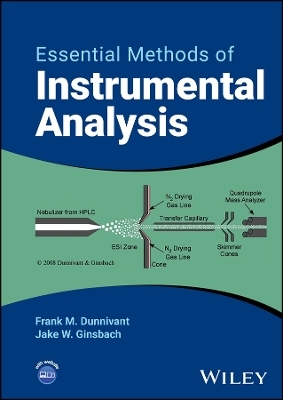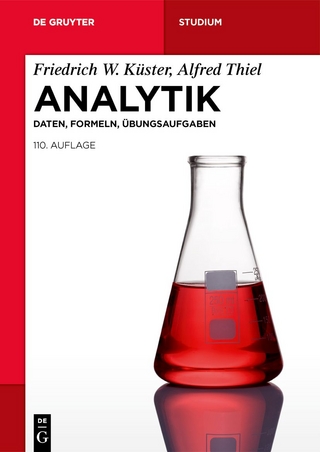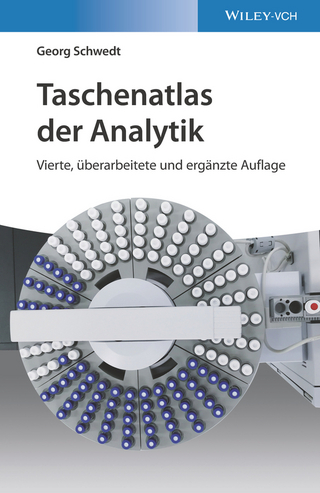
Essential Methods of Instrumental Analysis
John Wiley & Sons Inc (Verlag)
978-1-394-22671-9 (ISBN)
Through an analytical approach, Essential Methods of Instrumental Analysis provides an expansive overview of common instruments and methods and their applications for undergraduate students, integrating experimental protocols with real result examples to deliver a well-rounded understanding of the inner workings of the instruments and enabling students to evaluate the success of their experiments and create scientific figures.
In addition to detailed coverage of specific instruments, the book discusses analytical laboratory practices, instrument maintenance, statistics, and real-world lab experiments with previous student results. Each analytical method section includes extensive sample preparation information, rather than a simple stand-alone chapter offering generic discussions not connected to specific methods.
This book conveniently organizes content by analyte class (inorganic and organic) in a way that is intuitive to a student and aligned with relevant courses. Ancillaries including .mp4 videos, instructor PowerPoint slides, and animations are included on a companion website.
Written by an experienced professor and tested and refined over years in his courses since 2008, Essential Methods of Instrumental Analysis includes information on sample topics such as:
Proper laboratory protocols for analytical instrumentation, covering chemical reagents, glassware, calibration techniques, and figures of merit
Optical physics, covering the interaction of electromagnetic radiation with instrument components and sample molecules, relaxation processes, reflection, diffraction, dispersion, and refraction
Flame atomic absorption and flame emission spectrometry, covering optical radiation sources, mirrors, choppers, burner heads, and doppler broadening
Gas and liquid chromatography, covering gaseous, liquid, soil-sediment, and biological samples, analyte recovery, chromatography theory, injectors, columns and ovens, common detectors, and mass spectrometers
Focusing on contrasts and comparisons across multiple types of instruments in a way distinct from similar texts, Essential Methods of Instrumental Analysis is an essential textbook for students in advanced undergraduate courses in related programs of study.
Frank M. Dunnivant, PhD is a Professor in the Department of Chemistry at Whitman College. He has worked for several labs including the Oak Ridge National Laboratory, the Idaho National Engineering Laboratory, and the University of Zurich (ETH) and the Swiss Federal Institute for Water and Waste Water Pollution (EAWAG). Jake W. Ginsbach, PhD is a Principal Consultant at Kaiser Permanente. At Stanford and Whitman College, his research included lab analyses of environmental chemicals and contaminants, studying the activation of dioxygen at copper active sites in metalloenzymes, along with helping develop two e-textbooks.
About the Authors xv
Preface xix
About the Companion Website xxi
1 Proper Laboratory Protocols for Analytical Instrumentation 1
1.1 Laboratory Preliminaries 1
1.2 Standard Practices 11
1.3 Questions 13
1.4 Problems 14
2 Statistical Analysis 17
2.1 Introduction 17
2.2 Linear Least-squares Analysis 18
2.3 Student’s t-test Equations 20
2.4 Assignments 24
Further Reading 24
3 A Review of Optical Physics 25
3.1 Introduction 25
3.2 Interaction of Electromagnetic Radiation with Sample Molecules 26
3.3 Interaction of Electromagnetic Radiation with Surfaces 32
3.4 Detectors in UV–visible Spectrometry 41
3.5 Summary 48
Reference 49
3.6 Questions 49
Supporting Information 51
4 Analytical Molecular Spectrometry 53
4.1 Introduction 53
4.2 Basic UV–Vis Spectrometer 53
4.3 From Simple to Complex UV–Visible Spectrometers 54
4.4 Fluorescence and Phosphorescence Instruments 55
4.5 Instrument Maintenance 57
4.6 Summary 57
4.7 Case Study: Quantitation of Riboflavin by UV–Vis and Fluorescence Spectrometry by Nate Boland 60
5 Flame Atomic Absorption and Flame Emission Spectrometry 61
5.1 Introduction and History of Atomic Absorption Spectrometry (AAS) 61
5.2 Components of a Flame Atomic Absorption/Emission Spectrometer System 61
5.3 Specialized Sample Introduction Techniques and Analysis 73
5.4 General Operation of FAAS and FAES Instruments 76
5.5 Maintenance 76
5.6 Summary 76
5.7 Questions 77
Supporting Information 78
6 Inductively Coupled Plasma 79
6.1 Introduction and History 79
6.2 Atomic Emission Spectrometry Theory 79
6.3 Components of an Inductively Coupled Plasma: Atomic Emission Spectrometry System (ICP–AES) 80
6.4 Interferences 90
6.5 Maintenance 90
6.6 Case Study: Quantitation of Heavy Metals in Consumer Products by Dan Burgard 90
6.7 Summary 91
6.8 Questions 92
Supporting Information 92
References 93
7 Inductively Coupled Plasma–Mass Spectrometry 95
7.1 Introduction and History 95
7.2 Components of a Mass Spectrometer 95
7.3 Summary 112
7.4 Questions 113
Supporting Information 115
Reference 115
Further Reading 115
8 Contrasts and Comparisons of Instrumentation 117
8.1 Introduction 117
8.2 Figures of Merit 117
8.3 Questions 120
9 Chromatography Introduction, Chromatography Theory, and Instrument Calibration 121
9.1 Introduction 121
9.2 Chromatographic Theory 122
9.3 Case Study 129
9.4 Optimization of Chromatographic Conditions 131
9.5 Calibration of an Instrument/Detector 133
9.6 Evolution of Peak Integration 135
Supporting Information 136
References 136
10 Gas Chromatography 137
10.1 Introduction and History 137
10.2 Types of Samples and Sample Introduction 137
10.3 Gas Chromatography 143
10.4 Advanced GC Systems 152
10.5 Applications/Case Studies 152
10.6 Summary 160
10.7 Questions 161
Supporting Information 162
Reference 162
11 High-performance Liquid Chromatography 163
11.1 Introduction and History 163
11.2 Types of Analytes, Samples, and Sample Introduction 165
11.3 Liquid Chromatography 166
11.4 Advanced and Specialty LC Systems 173
11.5 Applications/Case Studies 177
11.6 Summary 180
11.7 Questions 180
Supporting Information 182
References 182
12 Capillary Electrophoresis by Nicole James 185
12.1 Introduction 185
12.2 Electrophoresis and Capillary Electrophoresis 185
12.3 Samples 190
12.4 Methods of Operation 192
12.5 Detectors 195
12.6 Application/Case Studies 199
12.7 Summary 202
References 202
13 Mass Spectrometry 203
13.1 Introduction and History 203
13.2 Sample Introduction from GC and Analyte Ionization 204
13.3 Introduction of Samples from HPLC 210
13.4 Introduction of Samples from a Capillary Electrophoresis System 214
13.5 Common Mass Filters (Mass Analyzers) 216
13.6 Ion Detectors 238
13.7 Three-dimensional Aspects of GC–MS 239
13.8 Summary 239
13.9 Questions 240
Supporting Information 242
References 242
Further Reading 242
14 Fragmentation and Interpretation of Spectra 245
14.1 Introduction 245
14.2 Creation of the Spectra 246
14.3 Identifying the Molecular Ion Peak 247
14.4 Use of the Molecular Ion 249
14.5 Identification of Analytes Using Isotopic Ratios 252
14.6 Fragmentation 255
14.7 Rearrangements 257
14.8 Identification of Compounds 257
14.9 Fragmentation of Hydrocarbons 258
14.10 Fragmentation of Alcohols 262
14.11 Fragmentation of Ketones and Aldehydes 265
14.12 Fragmentation of Carboxylic Acids 270
14.13 Fragmentation of Ethers 271
14.14 Fragmentation of Esters 273
14.15 Fragmentation of Amines 276
14.16 Fractionation of Amides 278
14.17 Fragmentation of Nitriles 279
14.18 Reviewing General Principles 280
14.19 Searchable Databases 284
15 Common Radiochemical Detection Methods in Analytical Chemistry 285
15.1 Introduction 285
15.2 Common Sources of Radiation 285
15.3 Detection of Alpha, Beta, and Gamma Emission 286
15.4 Case Studies 290
Reference 290
16 Instrumental Laboratory Experiments with Results 291
16.1 Introduction 291
16.2 A Typical Glassware Inventory for an Instrumental Methods Course 291
16.3 Maintaining a Legally Defensible Laboratory Notebook 291
16.4 Solutions, Weights, and Laboratory Techniques 293
16.5 Determination of a Surrogate Toxic Metal (Ca) in a Simulated Hazardous Waste Sample by a Variety of Techniques 295
16.6 Identification of Components in Liquors and Distilled Spirits 306
16.7 Identification of Fragrances 311
16.8 GC–MS Analysis of Synthetic and Natural Fragrances by Evan Bowman, Annika Mayo, and Aurora Anderson 316
16.9 SPME–GC–MS Analysis of Wine Headspace by Bailey Arend 324
16.10 Quantitative Determination of the Presence of Captan on Organic and Nonorganic Strawberries by Peter Mullin, Eric Ying, Jon Na, Sharon Ndayambaje, and Soren Sandeno 330
16.11 Determination of Nicotine in Human Urine Using HPLC–MS by Ashley Nguyen, Lea Molacek, Maxwell Brown 333
16.12 Analysis of Caffeine in Urine Samples Using GC–FID by Elsa Nader, Ralph Huang, Aaron Lieberman, Jane Duncan, and Matt Sousa 336
16.13 Caffeine in the Walla Walla (WA) Wastewater Effluent by MacKenzie Cummings, Mia Groff, Roya Nasseri, Noah Willis, and Clara Wheeler 338
16.14 Gasoline Analysis by GC–FID and GC–MS by Theodore Pierce and Austin Shaff 340
16.15 GC–MS as an Effective Instrument for Detecting Cocaine on US Currency by Jessica Boyers and Kacey Godwin 343
16.16 Analytical Quantification of CBD-A Content in Cannabis sativa (Hemp) Using GC–FID and GC–MS by Lauren Yumibe, Sam Weiss, Maddie Bowers, Tori Li, Asher Bachtold, and Brandon Neifert 347
16.17 Results and Discussion 349
16.18 Conclusions 350
References 351
Further Reading 354
Index 357
| Erscheinungsdatum | 22.08.2024 |
|---|---|
| Verlagsort | New York |
| Sprache | englisch |
| Maße | 183 x 254 mm |
| Gewicht | 975 g |
| Themenwelt | Naturwissenschaften ► Chemie ► Analytische Chemie |
| Naturwissenschaften ► Chemie ► Technische Chemie | |
| Technik | |
| ISBN-10 | 1-394-22671-3 / 1394226713 |
| ISBN-13 | 978-1-394-22671-9 / 9781394226719 |
| Zustand | Neuware |
| Informationen gemäß Produktsicherheitsverordnung (GPSR) | |
| Haben Sie eine Frage zum Produkt? |
aus dem Bereich


